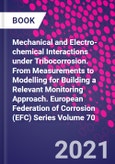Mechanical and Electro-chemical Interactions under Tribocorrosion: From Measurements to Modelling for Building a Relevant Monitoring Approach looks at progress in the field of tribocorrosion. The work is a result of the efforts of the European tribocorrosion community gathered under the auspices of the European Corrosion Federation (EFC) within WP18 Tribocorrosion. In addition to the handbook, Testing Tribocorrosion of Passivating Materials Supporting Research and industrial Innovation published in 2012, this release describes the latest scientific approaches recognized and validated experimentally to address tribocorrosion. Sections look at the phenomena of coupling through an understanding of the associated mechanisms and how to identify variables.
Final sections cover strategies to control and/or extend the life of structures in a multi-process coupling situation and an in-depth description of the current state-of-the-art on modeling approaches of tribocorrosion.
Please Note: This is an On Demand product, delivery may take up to 11 working days after payment has been received.
Table of Contents
1. What about Surface and Volume: From oligocyclic mechanical sollicitation
2. Stress effects on electrochemical activity: Metallurgical / stress interactions and surface reactivity
3. Effects in tribocorrosion processes: Overwiew of industrial case studies
4. In situ and ex situ characterizing techniques to study mechanical and chemical coupling -Tribocorrosion
5. Laboratory tests: From the repeatability and reliability of results
6.�Use of Pearson's correlation coefficients to identify mechanical-physical-chemical Parameters controlling the tribocorrosion behaviour of metallic alloys at the local scale
7. Modeling Fretting Wear: A global-local energy wear approach
8. Harmonic analysis of pin-on-disc tribocorrosion. Identification of repassivation kinetics and separation of reactive (corrosion) and mechanical (wear)
9. Modelling erosion-corrosion in metals: The effect of elastic rebound and impact angle on erosion-corrosion maps
Authors
Pierre Ponthiaux Ecole Centrale Paris, France. Pierre Ponthiaux obtained his Ph.D., in Materials Science, in 1990 at the doctoral school of Ecole Centrale Paris. In 1997 he got his academic qualification to conduct research, and he became full professor in 2009. The title of Doctor Honoris Causa of ''Dunarea de Jos'' University of Galati (Ro) was conferred to him in July 2010. At the Ecole Centrale Supelec, his research team on "Mechanical-chemical behaviour of surfaces - Tribocorrosion" was closely related to fields of "Physico-chemistry of interfaces� and "Life cycle of materials�. Since Nov 2015 he has been Honorary Professor of Paris-Saclay University - France.He is Secretary of the Scientific and Technical Committee of the CEFRACOR (F), and Founder & Vice-Chairman of the Working Party (WP18) on Tribocorrosion of the European Federation of Corrosion (EFC). He is a member of the Scientific Board of ''Journal of Bio- and Tribo-Corrosion'' launched in 2015 by Springer, as well as "The Annals of Dunarea de Jos� - Univ. Of Galati. Fascicle IX. Jean-Pierre Celis Surface Engineering and Tribology, KU.Leuven, Belgium. Jean-Pierre Celis is emeritus professor with the KU Leuven, as well as visiting professor at Kyoto University 2015-2016
His Work focusses on Surface Technology, Degradation of Materials, Materials for microelectronics, Surface engineering and tribology. In addition, he serves as the scientific coordinator of the research group on Surface Engineering and Tribology, KU.Leuven. He is a Board Member & Director R&D of spin-off company Falex Tribology N.V. He is a member of the editorial boards of "Industrial Lubrication and Tribology�, "International J. of Surface Science and Engineering�, "Tribocorrosion�, and "Metallurgical Research and Technologies�. Dr. Celis is presently the founder & chairman of Working Party (WP18) on Tribocorrosion, European Federation of Corrosion (EFC).








